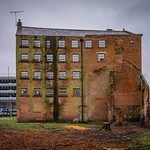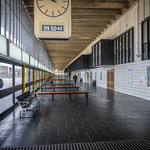- Preston City Council local elections 2024 candidates list set out
- Blog Preston reaches crowdfunding goal for expanded arts and culture coverage
- Harris Institute owners move to squash ‘for sale’ rumours
- “Unacceptable” and “must do better” as Preston records highest rough sleeper count since records began
- Preston Animate cinema reaches highest point in construction
Opinion: Tragic tale of Preston Bus Station is unlikely to result in resurection
Posted on - 14th January, 2013 - 8:40am | Author - Martyn Rawlinson | Posted in - Opinion, Politics, Preston Bus Station
Confetti rains down outside the Bus Station during the Preston Passion
When the BBC re-created the crucifixion on Preston Bus Station last Easter, few people realised that the venue was about to become the altar for its own sacrifice a few months later. The concrete monolith may have formed a dramatic backdrop for the re-telling of a 2000 year old story, but the building has its own tragic tale to tell, one which is unlikely to end with a resurrection.
AdvertisementIn the late 1960’s and early 1970’s local government was awash with money. Just look at Preston; the market hall, the bus station and the Guild Hall were all built entirely from public funds. The population boom created an expectation that space would be at a premium, so buildings became multi-story, utilising height and underground levels for optimum effect. Concrete met the needs of speed, cost and flexibility as a modern building material and was used to stunning effect in the largest bus station in Western Europe.
It was twenty years before the social and economic landscape began to cast a shadow over local government’s ‘golden age’ extravagances. Right wing politics saw the end of ‘corporation buses’. Local government reorganisation also saw public functions split into two tiers, resulting in a strange mix of transport responsibilities and assets over different authorities. As the country came out of recession in the late 1990’s, politicians and developers saw Preston’s potential for renewal and realised that at least two of the town’s once proud amenities were now an obstacle to growth. The market hall and bus station, either too drab or too big, did not fit clean and fast commercial living.
Rightly or wrongly, this led Preston to neglect its concrete legacies for the next decade. When the next recession came around, before a brick was laid in the doomed Tithebarn redevelopment scheme, the Market Hall was on its last legs and the bus station cast an imposing shadow of its former self.

So what does the public sector do at this point? Preston City Council, still trying to punch above its district council weight and even giants Lancashire County Council struggling against the severity of austerity have moved to rationalise their assets and operations, renew rather than refurbish, in the hope that it stirs the almost comatose private sector back to life.
While the market traders rose briefly yet indignantly against plans to re-house them, it was always going to be the bus station that created a passion play. Yet, despite the international outcry, the few campaigners who turned up at the Cabinet meeting had no response to the plain fact of the balance books. The Leader of the Council threw the Save the Bus Station disciples one last hope in the form of a wealthy Messiah. The emergence of such a selfless saviour however, seems unlikely given the understandable caveats required by the council on the renovation of the building.
As a Prestonian born the same year as the opening of the bus station, the last thing I want is to see Preston’s claim-to-fame demolished. As the Cabinet Member for Resources on Preston Council I am still seeking a solution that doesn’t include a wrecking ball. Renovation of the fledgling city’s oversized legacy is too much of a financial risk for either council to contemplate at the current estimates. An entrepreneur will be more interested in profit than preservation. A philanthropist is just a pipe dream.
I believe the last hope for Preston Bus Station is the creation of a charitable trust. A group of dedicated professionals with the time and the expertise to take on this challenge with a dowry from the two councils. It would only be possible if the second opinion on the renovation costs suggested that the old bus station could be made fit for purpose and profitable for the same cost as a new one; even then it would need a full structural survey with a favourable outcome. It would also need the currently incoherent and disparate ‘save the bus station’ campaigners to form a singular voice and vision…in other words, a miracle of biblical proportions.
What do you think? Could the Bus Station be saved? Do you agree or disagree with Councillor Rawlinson? Let us know in the comments below











 Advertisement
Advertisement